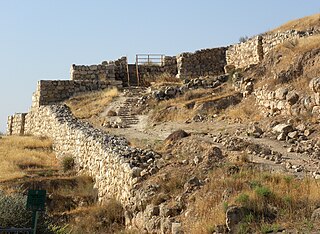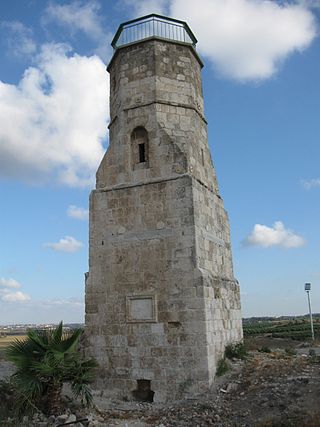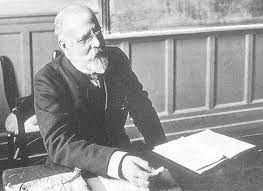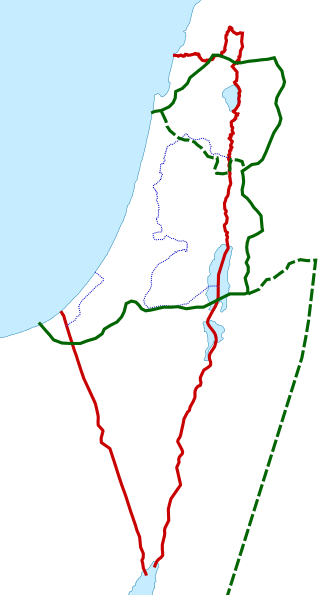
Lachish was an ancient Canaanite and Israelite city in the Shephelah region of Israel, on the south bank of the Lakhish River, mentioned several times in the Hebrew Bible. The current tell (ruin) by that name, known as Tel Lachish or Tell ed-Duweir, has been identified with the biblical Lachish. Today, it is an Israeli national park operated and maintained by the Israel Nature and Parks Authority. It lies near the present-day moshav of Lakhish.

Yibna, or Tel Yavne, is an archaeological site and depopulated Palestinian town. The ruins are located immediately southeast of the modern Israeli city of Yavne.

Charles Simon Clermont-Ganneau was a noted French Orientalist and archaeologist.

Palestine is a geographical region in West Asia. Situated in the Southern Levant, it is usually considered to include Israel and the State of Palestine, though some definitions also include parts of northwestern Jordan. Other historical names for the region include Canaan, the Promised Land, the Land of Israel, or the Holy Land.

The Palestine Exploration Fund is a British society based in London. It was founded in 1865, shortly after the completion of the Ordnance Survey of Jerusalem by Royal Engineers of the War Department. The Fund is the oldest known organization in the world created specifically for the study of the Levant region, also known as Palestine. Often simply known as the PEF, its initial objective was to carry out surveys of the topography and ethnography of Ottoman Palestine – producing the PEF Survey of Palestine. Its remit was considered to fall between an expeditionary survey and military intelligence gathering. There was also strong religious interest from Christians; William Thomson, Archbishop of York, was the first President of the PEF.

John Garstang was a British archaeologist of the Ancient Near East, especially Egypt, Sudan, Anatolia and the southern Levant. He was the younger brother of Professor Walter Garstang, FRS, a marine biologist and zoologist. Garstang is considered a pioneer in the development of scientific practices in archaeology as he kept detailed records of his excavations with extensive photographic records, which was a comparatively rare practice in early 20th-century archaeology.

The Israel Exploration Society (IES), originally the Jewish Palestine Exploration Society, is a society devoted to historical, geographical and archaeological research of the Land of Israel. The society was founded in 1913 and again in 1920, with the object of studying the history and civilization of the Land of Israel and of disseminating its knowledge.
Bi'ina or al-Bi'na is an Arab town in the Northern District of Israel. It is located east of Akko. In 2003, Bi'ina merged with Majd al-Krum and Deir al-Asad to form the city of Shaghur, but was reinstated as a local council in 2008 after Shaghur was dissolved. Bi'ina has a mostly Muslim population (92%) with a small Christian minority (8%); in 2022 its population was 8,629.
Hizma is a Palestinian town in the Jerusalem Governorate, seven kilometers from Jerusalem's Old City. The town, mostly located in Area C of the West Bank, borders four Israeli settlements, Neve Yaakov and Pisgat Ze'ev, Geva Binyamin and Almon. Since 1967, Hizma has been occupied by Israel. The village is cut off from Jerusalem by the Israeli West Bank barrier in the west and from the West Bank by settlements in the east. As of 2017, Hizma had a population of about 7,118 residents.

Tawfiq Canaan was a pioneering Palestinian physician, medical researcher, ethnographer, and Palestinian nationalist. Born in Beit Jala during the rule of the Ottoman Empire, he served as a medical officer in the Ottoman army during World War I.

Sebastia is a Palestinian village of about 3,205 inhabitants, located in the Nablus Governorate of the State of Palestine, some 12 kilometers northwest of the city of Nablus.
Khirbet Kerak or Beth Yerah is a tell located on the southern shore of the Sea of Galilee in modern-day Israel. The tell spans an area of over 50 acres—one of the largest in the Levant—and contains remains dating from the Early Bronze Age and from the Persian period through to the Early Islamic period.

Leo Aryeh Mayer OBE, was an Israeli scholar of Islamic art and rector of the Hebrew University of Jerusalem.
The Kenyon Institute, previously known as the British School of Archaeology at Jerusalem (BSAJ), is a British research institute supporting humanities and social science studies in Israel and Palestine. It is part of the Council for British Research in the Levant (CBRL) and is supported by the British Academy.
The Department of Antiquities was a department of the British administration of Mandatory Palestine from 1920 to 1948 that was in charge of the protection and investigation of archaeological remains and artefacts in Palestine.
John Winter Crowfoot CBE was a British educational administrator and archaeologist. He worked for 25 years in Egypt and Sudan, serving from 1914 to 1926 as Director of Education in the Sudan, before accepting an invitation to become Director of the British School of Archaeology in Jerusalem.
The Book of Joshua lists almost 400 ancient Levantine city names which refer to over 300 distinct locations in Israel, the West Bank, Jordan, Lebanon and Syria. Each of those cities, with minor exceptions is placed in one of the 12 regions, according to the tribes of Israel and in most cases additional details like neighbouring towns or geographical landmarks are provided. It has been serving as one of the primary sources for identifying and locating a number of Middle Bronze to Iron Age Levantine cities mentioned in ancient Egyptian and Canaanite documents, most notably in the Amarna correspondence.

Dimitri Constantine Baramki, often styled D. C. Baramki, was a Palestinian archaeologist who served as chief archaeologist at the Department of Antiquities of the Government of Mandatory Palestine from 1938 to 1948. From 1952 until his retirement, he was the curator of the Archaeological Museum at the American University of Beirut, Lebanon, where he served as a professor of archaeology.

James Buchanan Nies was an American episcopal minister and Assyriologist. He was president of the American Oriental Society in 1921.

Stephan Hanna Stephan (1894–1949), also St H Stephan, was a Palestinian writer, translator and radio broadcaster of history and folklore in Palestine. Besides publishing original articles, travel guides and phrasebooks in English and German, and broadcasting in Arabic, Stephan also produced several translations of books and inscriptions, utilizing his fluency in all these languages, as well as Ottoman Turkish and Syriac. Educated at the Schneller School, a German Protestant orphanage that operated in Jerusalem, he worked for the Mandatory Palestine authorities, first in the Treasury, and then in the Department of Antiquities.














